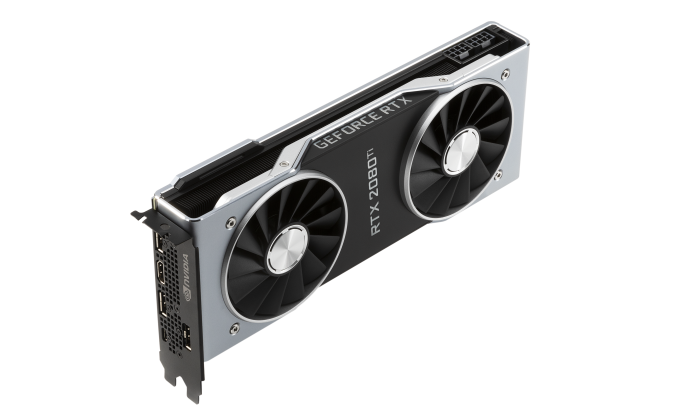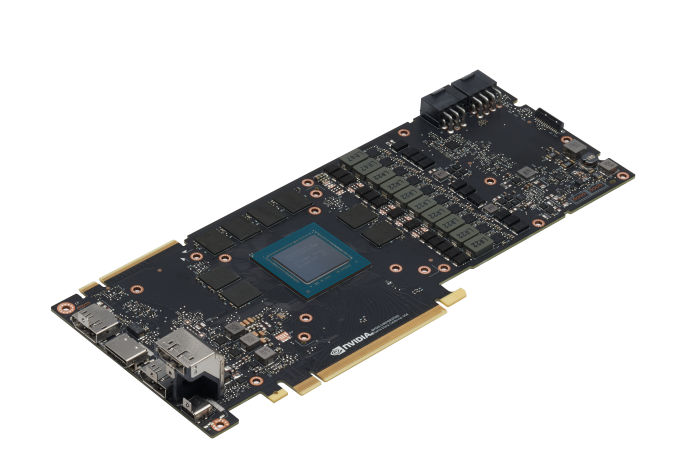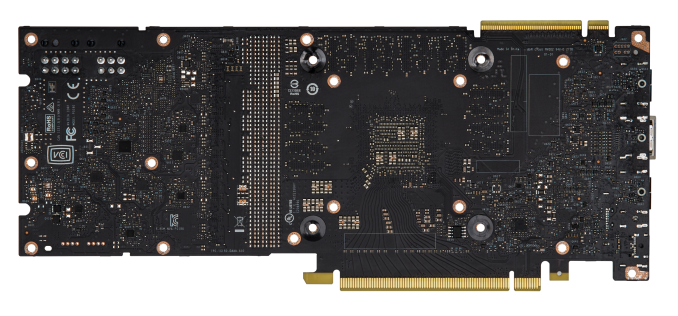The NVIDIA GeForce RTX 2080 Ti & RTX 2080 Founders Edition Review: Foundations For A Ray Traced Future
by Nate Oh on September 19, 2018 5:15 PM EST- Posted in
- GPUs
- Raytrace
- GeForce
- NVIDIA
- DirectX Raytracing
- Turing
- GeForce RTX
Meet The GeForce RTX 2080 Ti & RTX 2080 Founders Editions Cards
Moving onto the design of the cards, we've already mentioned the biggest change: a new open air cooler design. Along with the Founders Edition specification changes, the cards might be considered 'reference' in that they remain a first-party video card sold direct by NVIDIA, but strictly-speaking they are not because they no longer carry reference specifications.
Otherwise, NVIDIA's industrial design language prevails, and the RTX cards bring a sleek flattened aesthetic over the polygonal shroud of the 10 series. The silver shroud now encapsulates an integrated backplate, and in keeping with the presentation, the NVLink SLI connectors have a removable cover.
Internally, the dual 13-blade fans accompany a full-length vapor chamber and component baseplate, connected to a dual-slot aluminum finstack. Looking at improving efficiency and granular power control, the 260W RTX 2080 Ti Founders Edition features a 13-phase iMON DrMOS power subsystem with a dedicated 3-phase system for the 14 Gbps GDDR6, while the 225W RTX 2080 Founders Edition weighing in with 8-phases main and 2-phases memory.
As is typical with higher quality designs, NVIDIA is pushing overclocking, and for one that means a dual 8-pin PCIe power configuration for the 2080 Ti; on paper, this puts the maximum draw at 375W, though specifications-wise the TDP of the 2080 Ti Founders Edition against the 1080 Ti Founders Edition is only 10W higher. The RTX 2080 Founders Edition has the more drastic jump, however, with 8+6 pins and a 45W increase over the 1080's lone 8 pin and 180W TDP. Ultimately, it's a steady increase from the power-sipping GTX 980's 165W.
One of the more understated changes comes with the display outputs, which thanks to Turing's new display controller now features DisplayPort 1.4 and DSC support, the latter of which is part of the DP1.4 spec. The eye-catching addition is the VR-centric USB-C VirtualLink port, which also carries an associated 30W not included in the overall TDP.
Something to note is that this change in reference design, combined with the seemingly inherent low-volume nature of the Turing GPUs, cuts into an often overlooked but highly important aspect of GPU sales: big OEMs in the desktop and mobile space. Boutique system integrators will happily incorporate the pricier higher-end parts but from the OEM’s perspective, the GeForce RTX cards are not just priced into a new range beyond existing ones but also bringing higher TDPs and no longer equipped with blower-style coolers in its ‘reference’ implementation.
Given that OEMs often rely on the video card being fully self-exhausting because of a blower, it would certainly preclude a lot of drop-in replacements or upgrades – at least not without further testing. It would be hard to slot into the standard OEM product cycle at the necessary prices, not to mention the added difficulty in marketing. In that respect, there is definitely more to the GeForce RTX 20 series story, and it’s somewhat hard to see OEMs offering GeForce RTX cards. Or even the RT Cores themselves existing below the RTX 2070, just on basis of the raw performance needed for real time ray tracing effects at reasonable resolutions and playable framerates. So it will be very interesting to see how the rest of NVIDIA’s product stack unfolds.
















337 Comments
View All Comments
Vayra - Friday, September 21, 2018 - link
Why would I want a feature like DLSS when current AA methods do the job fine and we can also just run at native, higher resolution anyway and not use any AA whatsoever?And why would anyone care about vaporware like RTRT?
Lolimaster - Saturday, September 22, 2018 - link
No DLSS, NO.Blur.
Not capable of raytracing, just raytrace small parts of a frame on selected scenes on selected games...
Gastec - Thursday, September 27, 2018 - link
You must be joking right? What do we care if the price of manufacturing increased for Nvidia. We are mot supporters, we are clients. We don't have to support their pricing because WE ARE NOT SOCIOS! Let Nvidia reduce their costs by cutting the salaries of their CEOs and other wortless corporate officers. Then I will BUY their 2080Ti product, at the consumer-friendly price of €750Andrew LB - Thursday, September 20, 2018 - link
Except for the fact that the non founders edition is $999, not $1200. And the GTX 1080ti released at $699 but for the better part of the past two years cost substantially more.eva02langley - Thursday, September 20, 2018 - link
Then find one at that price, genius.3rd parties are OC their cards and offering additional cooling solutions, they will all be over the MSRP and close to the FE.
Also, they use GDDR6... you didn't learn anything from Vega and HBM2?
jeffcd57 - Thursday, September 20, 2018 - link
Agree the cost is ridiculous. I haven't paid it and won't. Got to many children to raise. I've never seen them at the above mentioned.jeffcd57 - Thursday, September 20, 2018 - link
1080 Ti for $600, where, when?ezridah - Thursday, September 20, 2018 - link
A month ago.https://www.theverge.com/good-deals/2018/8/21/1776...
TheJian - Thursday, September 20, 2018 - link
So buy a 1080ti. For some the new features are worthy and boost perf quite massively making it truly worth it if those technologies are the new way forward. At worst, a good 25 games are already coming with NV's new tech. Many are huge titles most would like to play surely.Also as Hexus noted a while back, the price to make these things is just below MSRP. Note the small chip is as large as a titan, and the larger chips...WOW. That's a lot of transistors for a game card. Also apples vs. oranges here, as said by others 1080 etc can't do raytracing or dlss.
https://nvidianews.nvidia.com/news/nvidia-rtx-plat...
27 games coming with NV tech. Will they look the same on 1080ti or less? NOPE. Will they be faster and BETTER looking on RTX...YEP. Value is in the eye of the beholder ;)
Spunjji - Friday, September 21, 2018 - link
The problem is, you just counted twice when you said "will they be faster and better looking on RTX".The absolute truth of it from what little we can glean so far (after the official launch!!!) is that you can have RTX effects /OR/ you can have your better performance, not both. That's a heavy caveat!
It would be one thing if it were a proposition of waiting a couple of months for some amazing features that will knock your socks off and have few drawbacks. It's another to be paying over the odds for a card now to maybe get some cool stuff that will DEFINITELY run slower and at a lower res than you're used to.